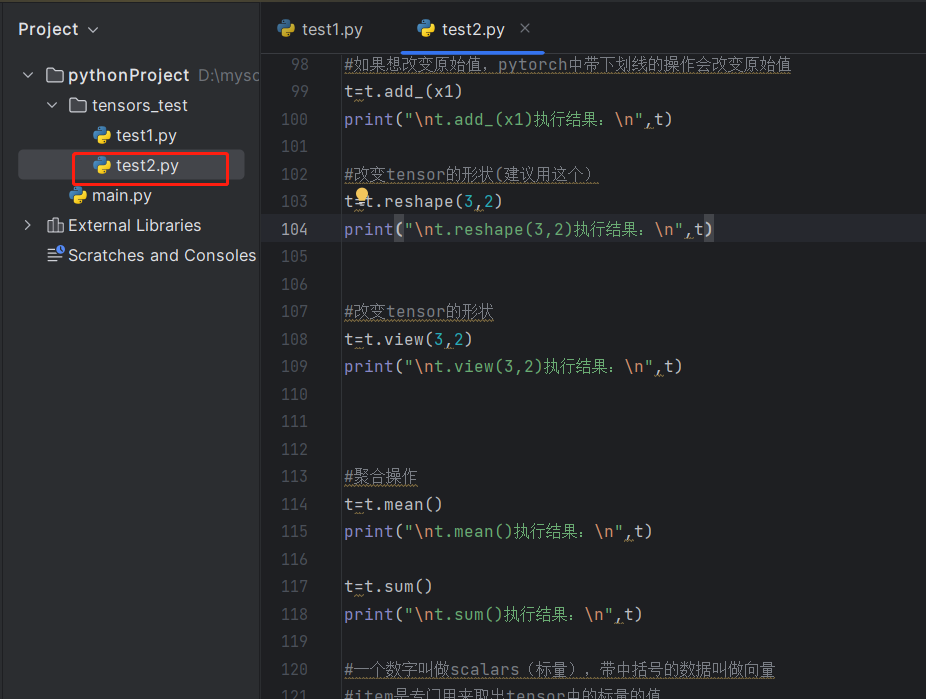1、构建项目

2、编辑test2.py

1 import torch 2 import numpy as np 3 import tensorflow as tf 4 #1. pytorch张量 5 #pytorch中的张量和tensorflow的tensor是一样的,名字都一样 6 #pytorch中的张量也叫tensor 7 #tensor和numpy中的ndarray也是一个意思。只不过tensor可以在GPU上加速计算 8 #创建tensor 9 x=torch.tensor([6,2],dtype=torch.int32) 10 print("\ntorch.tensor([6,2],dtype=torch.int32)执行结果:\n",x) 11 #输出结果为:tensor([6, 2], dtype=torch.int32) 12 13 x=torch.tensor((6,2)) 14 print("\ntorch.tensor((6,2))执行结果:\n",x) 15 #输出结果为:tensor([6, 2]) 16 17 x=torch.tensor(np.array([6,2])) 18 print("\ntorch.tensor(np.array([6,2]))执行结果:\n",x) 19 #输出结果为:tensor([6, 2], dtype=torch.int32) 20 21 #快速创建tensor的方法,和numpy中的routines方法一样 22 #ones,zeros,full,eye,random.randn,random.normal...arange...random.rand,random,random 23 #创建一个0到1之间的随机数组成的tensor 24 x=torch.rand(2,3) 25 print("\ntorch.rand(2,3)执行结果:\n",x) 26 27 #标准正态分布 28 x=torch.randn(2,3) 29 print("\ntorch.randn(2,3)执行结果:\n",x) 30 31 x=torch.zeros(2,3) 32 print("\ntorch.zeros(2,3)执行结果:\n",x) 33 34 x=torch.ones(2,3) 35 print("\ntorch.ones(2,3)执行结果:\n",x) 36 37 #tensor的shape 38 x=torch.ones(2,3,4) 39 print("\ntorch.ones(2,3,4).shape执行结果:\n",x.shape) 40 41 #可以通过.size()方法获取形状 42 print("\ntorch.ones(2,3,4).size()执行结果:\n",x.size()) 43 44 #size中可以传shape的索引 45 print("\ntorch.ones(2,3,4).size(1)执行结果:\n",x.size(1)) 46 # 输出结果为: 47 # 3 48 49 #2.Tensor基本数据类型 50 # pytorch中的tensor有以下基本数据类型 51 # 32位浮点型: torch.float32 52 # 64位浮点型: torch.float64 53 # 32位整型: torch.int32 54 # 16位整型: torch.int16 55 # 64位整型: torch.int64 56 #我们可以在创建tensor的时候指定数据类型 57 x=torch.tensor([6,2],dtype=torch.float32) 58 print("\ntorch.tensor([6,2],dtype=torch.float32)执行结果:\n",x) 59 # 输出结果为: 60 #tensor([6., 2.]) 61 62 #tensorflow不能直接用tensor方法来创建tensor 63 #tensorflow提供了constant,Variable, 64 # tensor和ndarray很方便的进行转换 65 n=np.random.randn(2,3) 66 print("\nnp.random.randn(2,3)执行结果:\n",x) 67 68 a=torch.from_numpy(n) 69 a=a.numpy() 70 print("\ntorch.from_numpy(n).numpy()的执行结果:\n",a) 71 72 # numpy和tensor的数值进行转换 73 t=tf.constant(a) 74 print("\ntf.constant(a)的执行结果:\n",t) 75 76 print("\ntf.constant(a).numpy()的执行结果:\n",t.numpy()) 77 78 #3.张量的运算 79 #tensor运算规则和numpy的ndarray很像 80 # 和单个数字运算 81 t=torch.ones(2,3) 82 print("\ntorch.ones(2,3)和单个数字运算的执行结果:\n",t) 83 84 t=t+3 85 print("\nt+3执行结果:\n",t) 86 87 t=torch.add(t,3) 88 print("\ntorch.add(t,3)执行结果:\n",t) 89 90 x1=torch.ones(2,3) 91 #对应位置的元素相加,element-wise操作 残差网络的+ 就是element-wise相加 92 print("\ntorch.ones(2,3)+t执行结果:\n",x1+t) 93 94 #有输出不会改变原始值 95 t=t.add(x1) 96 print("\nt.add(x1)执行结果:\n",t) 97 98 #如果想改变原始值,pytorch中带下划线的操作会改变原始值 99 t=t.add_(x1) 100 print("\nt.add_(x1)执行结果:\n",t) 101 102 #改变tensor的形状(建议用这个) 103 t=t.reshape(3,2) 104 print("\nt.reshape(3,2)执行结果:\n",t) 105 106 107 #改变tensor的形状 108 t=t.view(3,2) 109 print("\nt.view(3,2)执行结果:\n",t) 110 111 112 113 #聚合操作 114 t=t.mean() 115 print("\nt.mean()执行结果:\n",t) 116 117 t=t.sum() 118 print("\nt.sum()执行结果:\n",t) 119 120 #一个数字叫做scalars(标量),带中括号的数据叫做向量 121 #item是专门用来取出tensor中的标量的值 122 t=t.item() 123 print("\nt.item()执行结果:\n",t)
3、运行结果如下:

